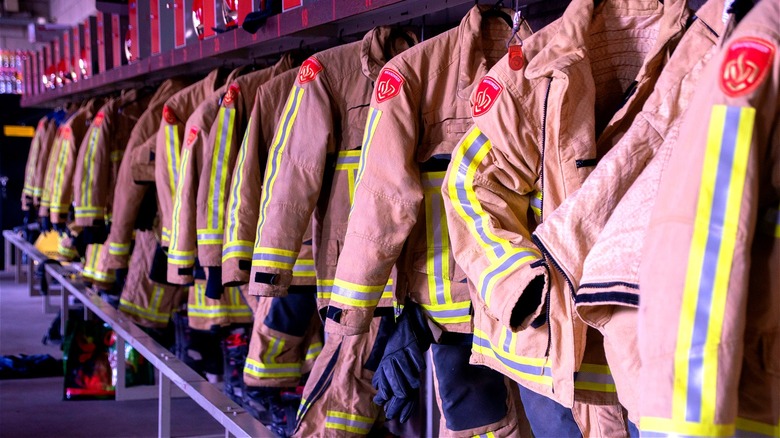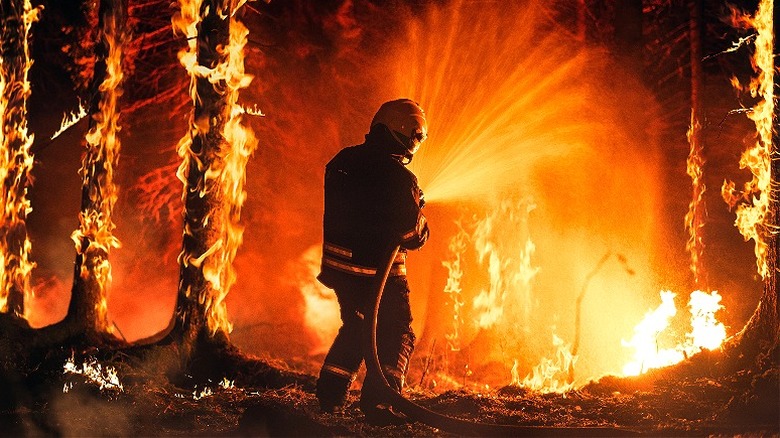Firefighters Make More Money Than You Realize
While all jobs feel like matters of life and death, some occupations truly are. Take firefighting, for example. A day's work as a firefighter could be spent getting a kitten out of a tree, or, far more likely, fighting back a blaze that could consume a kitchen, a home, or an entire building. By "day's work," we also mean night's work; some firefighters work overnight shifts that can be 12 to 14 hours long.
Nothing about firefighting seems particularly easy or glamorous, though the job seems immensely gratifying for those who know they've saved the day, or even a small piece of property. But what do firefighters earn for their long hours and dangerous hard work? In rural or other far-flung towns, the answer might be absolutely nothing. Volunteer firefighters might receive a nominal fee for answering emergency calls in a minor municipality, but not an hourly wage. In larger metro areas where cities pay for robust departments, however, firefighters make more money than you realize — which still might be less money than you expect.
Typical firefighter pay
According to the Bureau of Labor Statistics, the median salary for a United States firefighter (as of May 2023) is $57,120 a year. This middle-of-the-pack salary is close to the median for all firefighter and prevention workers, $57,900 a year, while it's nearly 16% more than the median salary for all occupations in the U.S. ($48,060).
It's a little astounding to think that firefighters make anything close to a typical salary, considering the inherent danger in their line of work. With $57,120 being their median salary, it's also alarming to think of firefighters earning far less than that. Per the Bureau of Labor Statistics, the lowest-earning 10% of firefighters take home less than $31,600 annually. The top 10%, meanwhile, earn $93,720.
So, why are some firefighters paid such average or below-average wages? One reason is that many entry-level firefighting jobs are considered seasonal work. For example, the USDA Forest Service's Seasonal Wildland Fire Employment website lists various temporary seasonal-hire roles for Region 4 (Northern Rocky Mountains, Middle Rocky Mountains, Colorado Plateau, and Great Basin). These roles are broken down by weeks needed for fire-season readiness.
Highest firefighter salaries
While ZipRecruiter cites the average yearly income for a firefighter is $59,606, firefighter salaries vary by state and by role. As noted, according to the Bureau of Labor Statistics, firefighters in the top 10% earn $93,720 a year. So, what factors into this significant differential? One factor is location. The statistics bureau reports the top-paying U.S. states are Illinois ($75,710), New York ($80,950), Washington ($83,630), and New Jersey ($84,850), with California paying its firefighters the most ($87,890). With the climate crisis as it is and California wildfire season as it is, the Golden State's ranking makes an unfortunate sort of sense.
Another factor that affects firefighter pay is specialty. Often, higher-paying firefighter roles require additional training, testing, and experience, as well as come with more responsibilities and possibly higher-stress duties. For example, lateral paramedic firefighters can earn (per ZipRecruiter) $120,828 a year. Firefighter chiefs, meanwhile, earn upward of $100,000 a year, while firefighter captains and engineers earn in the high $70,000 to low $80,000 annual range. While these salaries have nothing on the highest-paid NBA players or even approach what airline pilots make in a year, these numbers might light a fire, so to speak, when it comes to a possible career change.


